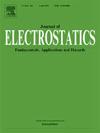Optimizing electric field uniformity of a segmented-electrode free-fall separator using RSM-FEM coupling
IF 2.1
4区 工程技术
Q3 ENGINEERING, ELECTRICAL & ELECTRONIC
引用次数: 0
Abstract
Electrostatic separation enables the efficient sorting of mixed granular insulating materials by applying controlled electrical and mechanical forces. Although particle separation requires a strong electric field (E-field), a uniform field distribution is critical to achieving consistent particle deflection and high separation efficiency. This study aimed to analyze the E-field non-uniformity (NUF) in free-fall electrostatic separator design incorporating segmented electrodes and inter-electrode side openings to mitigate particle rebound. Numerical simulations were conducted to optimize critical parameters—number of electrode pairs, inclination angle, and segmented length ratio—using a coupled computational approach: finite element analysis (FEM) in COMSOL Multiphysics for field modeling, integrated with response surface methodology (RSM) via central composite design (CCD) in JMP statistical software for parametric optimization. Key performance metrics included E-field NUF and the total distance between same-polarity electrodes. Quadratic regression modeling identified the optimal configuration to be eight electrode pairs with a segment length of 4.16 cm and an inclination angle of 16.88°, achieving 86 % desirability. Simulation results showed a strong correlation with model predictions (R2 > 0.99). Statistical analysis revealed that the number of electrode pairs was the most influential factor affecting E-field NUF, contributing to 49.75 % of the observed variance. Similarly, the segmented electrode length ratio had the strongest impact on inter-electrode distance, accounting for 65.91 % of the response variation. Compared to conventional configurations, the proposed design reduces E-field NUF by 44 %, demonstrating its potential for enhanced electrostatic separation performance.

利用RSM-FEM耦合优化分段电极自由落体分离器的电场均匀性
静电分离通过施加受控的电和机械力,使混合颗粒绝缘材料的有效分选成为可能。虽然颗粒分离需要强大的电场(e场),但均匀的电场分布对于实现一致的颗粒偏转和高分离效率至关重要。本研究旨在分析采用分段电极和电极间侧开口的自由落体静电分离器设计中的电场非均匀性(NUF),以减轻粒子反弹。采用耦合计算方法进行了数值模拟,以优化关键参数-电极对数,倾角和分段长度比-使用COMSOL Multiphysics中的有限元分析(FEM)进行现场建模,并通过JMP统计软件中的中心复合设计(CCD)集成响应面方法(RSM)进行参数优化。关键性能指标包括E-field NUF和同极性电极之间的总距离。二次回归模型确定了最优配置为8对电极,电极段长度为4.16 cm,电极倾角为16.88°,理想度达到86%。模拟结果显示与模型预测有很强的相关性(R2 > 0.99)。统计分析表明,电极对数是影响电场NUF的最主要因素,占观察方差的49.75%。同样,分段电极长度比对电极间距离的影响最大,占响应变化的65.91%。与传统配置相比,所提出的设计将E-field NUF降低了44%,表明其具有增强静电分离性能的潜力。
本文章由计算机程序翻译,如有差异,请以英文原文为准。
求助全文
约1分钟内获得全文
求助全文
来源期刊

Journal of Electrostatics
工程技术-工程:电子与电气
CiteScore
4.00
自引率
11.10%
发文量
81
审稿时长
49 days
期刊介绍:
The Journal of Electrostatics is the leading forum for publishing research findings that advance knowledge in the field of electrostatics. We invite submissions in the following areas:
Electrostatic charge separation processes.
Electrostatic manipulation of particles, droplets, and biological cells.
Electrostatically driven or controlled fluid flow.
Electrostatics in the gas phase.
 求助内容:
求助内容: 应助结果提醒方式:
应助结果提醒方式:


